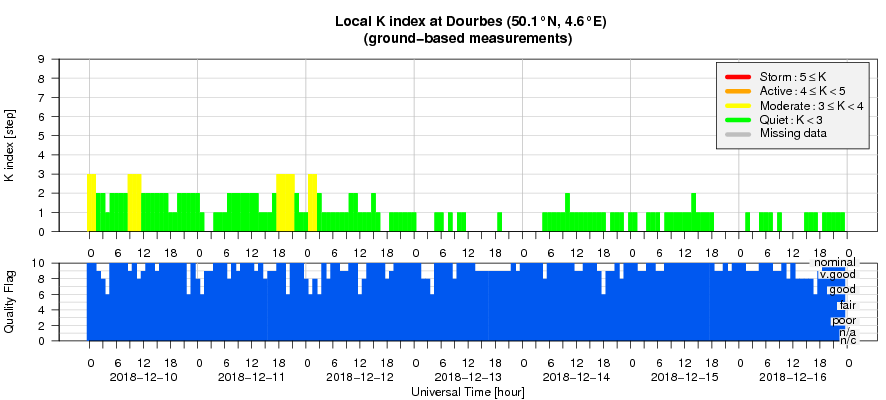- Table of Content
- 1.PECASUS takes ...
- 2.PROBA2 Observa...
- 3.Review of sola...
- 4.The Internatio...
- 5.Review of geom...
- 6.Geomagnetic Ob...
- 7.The SIDC space...
- 8.Review of iono...
- 9.Season's greet...
2. PROBA2 Observations (10 Dec 2018 - 16 Dec 2018)
3. Review of solar activity
4. The International Sunspot Number
5. Review of geomagnetic activity
6. Geomagnetic Observations at Dourbes (10 Dec 2018 - 16 Dec 2018)
7. The SIDC space weather briefing
8. Review of ionospheric activity (10 Dec 2018 - 16 Dec 2018)
9. Season's greetings
PECASUS takes off
The International Civil Aviation Organization (ICAO) has designated in November 2018 three global Space Weather Service Centers that will support aviation with observations and forecasts on near-Earth space and atmospheric conditions during strong solar storms. One is PECASUS, us!
What is the problem?
Sporadic and massive eruptions of very high-energy matter and radiation from the Sun can have a pronounced impact on the aeronautical ability to aviate, navigate and communicate. In extreme cases, these eruptions pose a safety risk to passenger health. Periods of extreme solar activity are generally referred to as space weather.
The exposure of the aviation community to space weather has increased since the opening of the northern polar routes at the end of the 20th century and ICAO has acted to incorporate safety from space weather effects into its aviation regulations.
What can PECASUS do about it?
PECASUS will provide civil aviation with information on space weather that has the potential to affect communications, navigation and the health of passengers and crew.
Concrete:
• Deliver 24/7 manned observance of solar activity and its impact at Earth
• Issue appropriate ICAO advisories to the aviation sector
• Provide a guaranteed data flow and operational resilience
• Host ICAO approved training for space weather operators and aviation users
• Operate comprehensive and robust IT infrastructure
What is in a name?
PECASUS (http://pecasus.eu) is the short term for the Pan-European Consortium for Aviation Space Weather User Services. It represents extensive technical and scientific expertise across European space weather institutions from nine countries: Austria, Belgium, Cyprus, Finland (Coordinator), Germany, Italy, the Netherlands, Poland and United Kingdom.
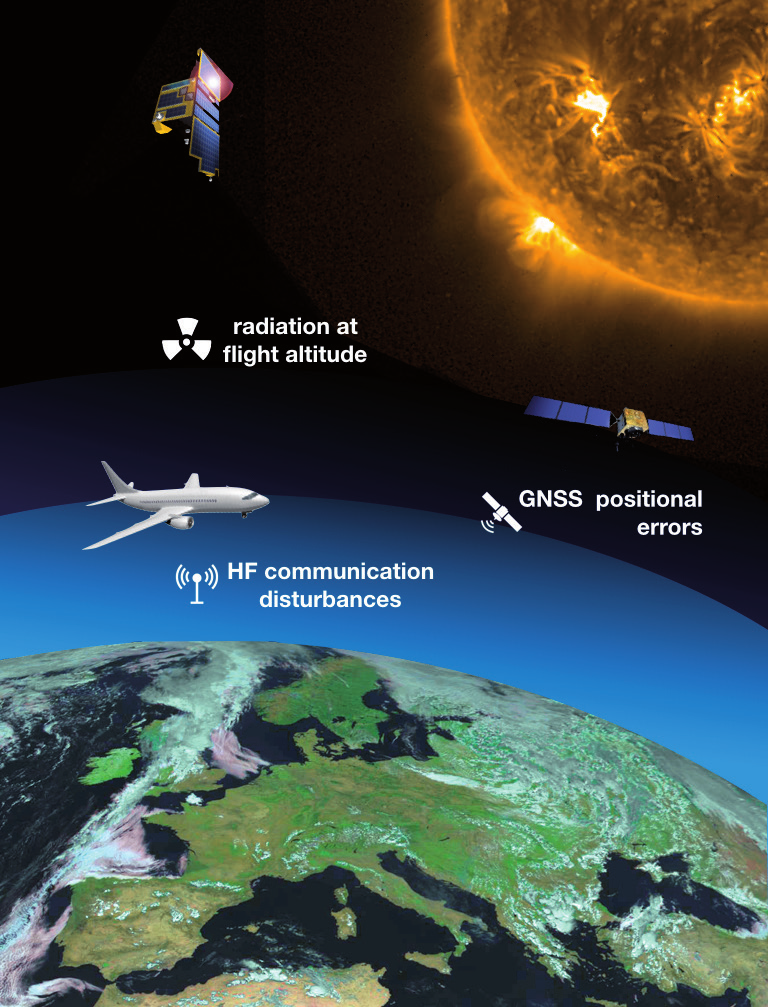
Fly PECASUS fly!!
PROBA2 Observations (10 Dec 2018 - 16 Dec 2018)
Solar Activity
Solar flare activity remained very low during the week.
In order to view the activity of this week in more detail, we suggest to go to the following website from which all the daily (normal and difference) movies can be accessed: http://proba2.oma.be/ssa
This page also lists the recorded flaring events.
A weekly overview movie can be found here (SWAP week 455): http://proba2.oma.be/swap/data/mpg/movies/weekly_movies/weekly_movie_2018_12_10.mp4
Details about some of this week's events, can be found further below.
If any of the linked movies are unavailable they can be found in the P2SC movie repository here: http://proba2.oma.be/swap/data/mpg/movies/
Wednesday Dec 12
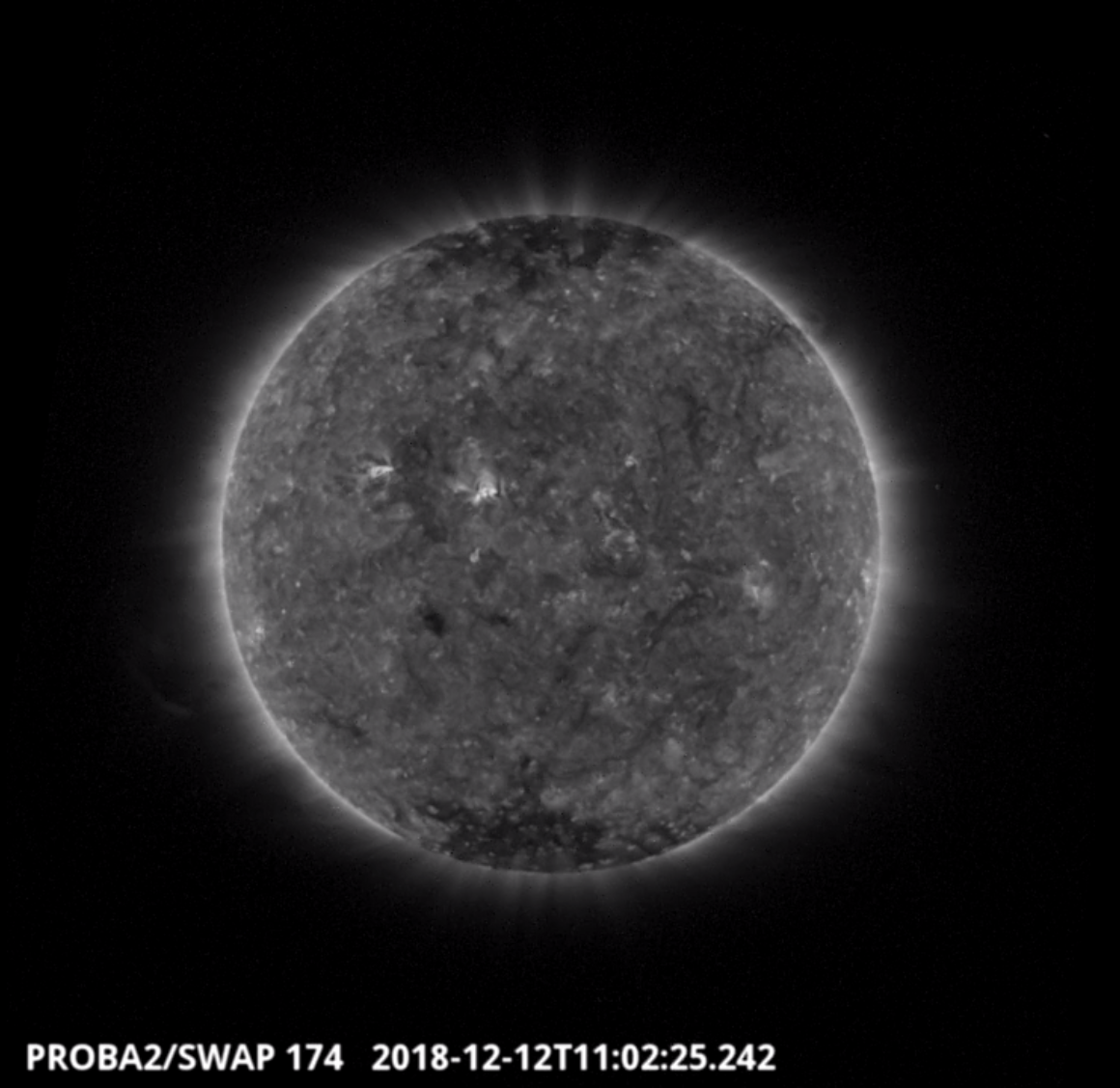
Flows on the eastern limb of the Sun were observed by SWAP on 2018-Dec-12, shown in the SWAP image above taken at 11:02 UT.
Find a movie of the event here (SWAP movie): http://proba2.oma.be/swap/data/mpg/movies/20181212_swap_movie.mp4
Saturday Dec 15
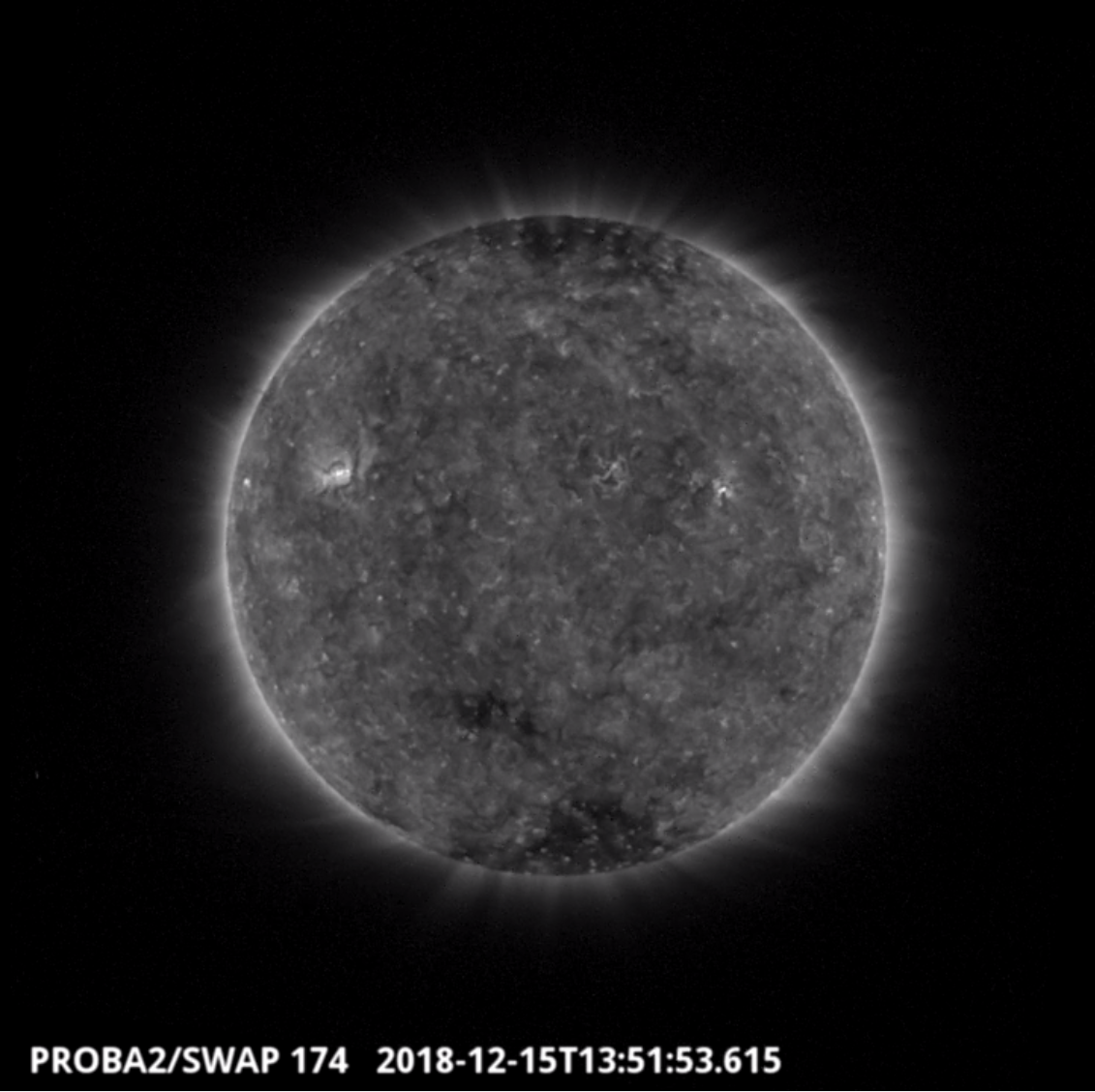
The largest flare of the week (B1.0), which was associated with NOAA AR2731, was observed by SWAP on 2018-Dec-15 and is visible in the north-east quadrant of the solar disk in the SWAP image above taken at 13:51 UT.
Find a movie of the event here (SWAP movie): http://proba2.oma.be/swap/data/mpg/movies/20181215_swap_movie.mp4
Review of solar activity
Three active regions on the Sun got a NOAA number: NOAA 2729, 2730 and 2731. NOAA 2729 rotated behind the West limb on December 10. NOAA AR 2730 got its number on December 12 and was at that moment located near the central meridian. NOAA AR 2731 earned its label as active region on December 15 when it was on the east side of the solar disk. Their only achievement w
The GOES X-ray background flux was at the A1-A2 level. GOES measured three B-flares.
No filament erupted, nor Earth-directed CMEs were seen.
The greater than 10 MeV proton flux stayed at nominal levels.
The International Sunspot Number
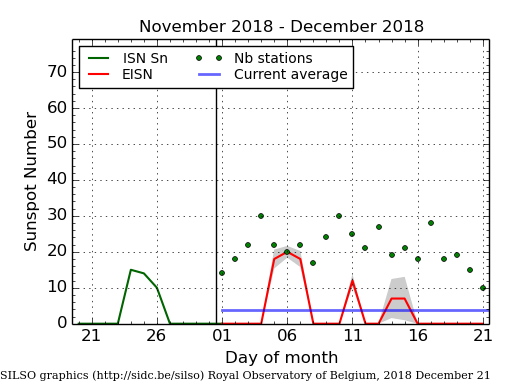
The daily Estimated International Sunspot Number (EISN, red curve with shaded error) derived by a simplified method from real-time data from the worldwide SILSO network. It extends the official Sunspot Number from the full processing of the preceding month (green line). The plot shows the last 30 days (about one solar rotation). The horizontal blue line shows the current monthly average, while the green dots give the number of stations included in the calculation of the EISN for each day.
Review of geomagnetic activity
The Earth was under the influence of a high speed stream associated with a negative polarity, equatorial-South polar coronal hole. The Co-rotating Interaction Region (with a magnitude of the magnetic field carried by the solar wind, Bt up to 11nT) passed the Earth on December 09. DSCOVR measured on December 10 a solar wind speed around 650 km/s. It gradually decreased to its minimum value around 350 km/s on December 13.
Apart from a few active intervals (K Dourbes = 4) on December 9 and 10, quiet to unsettled geomagnetic conditions (K Dourbes smaller than 4) were registered throughout the week.
The SIDC space weather briefing
The Space Weather Briefing presented by the forecaster on duty from December 10 to 16. It reflects in images and graphs what is written in the Solar and Geomagnetic Activity report.

The pdf-version: http://www.stce.be/briefings/20181217_SWbriefing.pdf
The automatically running presentation: http://www.stce.be/briefings/20181217_SWbriefing.ppsm
Review of ionospheric activity (10 Dec 2018 - 16 Dec 2018)
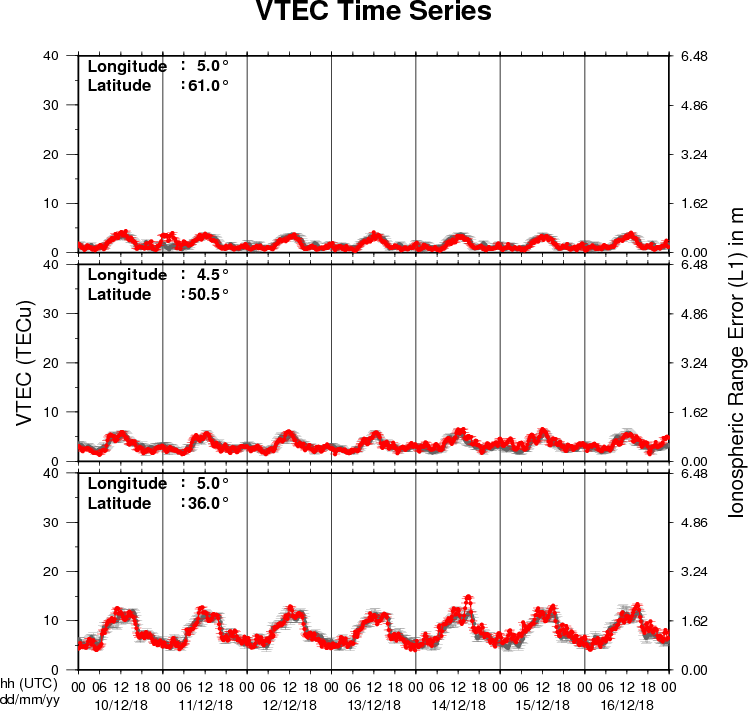
The figure shows the time evolution of the Vertical Total Electron Content (VTEC) (in red) during the last week at three locations:
a) in the northern part of Europe(N61°, 5°E)
b) above Brussels(N50.5°, 4.5°E)
c) in the southern part of Europe(N36°, 5°E)
This figure also shows (in grey) the normal ionospheric behaviour expected based on the median VTEC from the 15 previous days.
The VTEC is expressed in TECu (with TECu=10^16 electrons per square meter) and is directly related to the signal propagation delay due to the ionosphere (in figure: delay on GPS L1 frequency).
The Sun's radiation ionizes the Earth's upper atmosphere, the ionosphere, located from about 60km to 1000km above the Earth's surface.The ionization process in the ionosphere produces ions and free electrons. These electrons perturb the propagation of the GNSS (Global Navigation Satellite System) signals by inducing a so-called ionospheric delay.
See http://stce.be/newsletter/GNSS_final.pdf for some more explanations ; for detailed information, see http://gnss.be/ionosphere_tutorial.php
